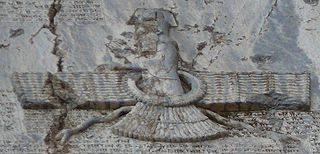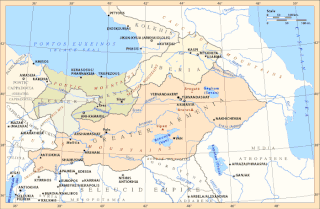 W
WAdurbadagan was a Sasanian province located in northern Iran, almost corresponded to the present-day Iranian Azerbaijan. Governed by a marzban ("margrave"), it functioned as an important frontier region against the neighbouring country of Armenia.
Airyanem Vaejah is the homeland of the early Iranians and a reference in the Zoroastrian Avesta to one of Ahura Mazda's "sixteen perfect lands". Its actual location remains uncertain.
 W
WAria is an Achaemenid region centered on the city of Herat in present-day western Afghanistan. In classical sources, Aria has been several times confused with the greater region of ancient Ariana, of which Aria formed a part.
 W
WAssyria, also called the Assyrian Empire, was a Mesopotamian kingdom and empire of the ancient Near East and the Levant that existed as a state from perhaps as early as the 25th century BC until its collapse between 612 BC and 609 BC – spanning the periods of the Early to Middle Bronze Age through to the late Iron Age. This vast span of time is divided into the Early Period, Old Assyrian Empire, Middle Assyrian Empire and Neo-Assyrian Empire.
 W
WBit-Istar was an Assyrian town and a local kingdom at western Zagros that according to inscriptions of Tiglath Pileser III and Sargon II. It was located close to the source of a river to the east of Dyala.
 W
WThe Caspians were a people of antiquity who dwelt along the southwestern shores of the Caspian Sea, in the region known as Caspiane. Caspian is the English version of the Greek ethnonym Kaspioi, mentioned twice by Herodotus among the Achaemenid satrapies of Darius and applied by Strabo. The name is not attested in Old Iranian.
 W
WElam was an ancient civilization centered in the far west and southwest of modern-day Iran, stretching from the lowlands of what is now Khuzestan and Ilam Province as well as a small part of southern Iraq. The modern name Elam stems from the Sumerian transliteration elam(a), along with the later Akkadian elamtu, and the Elamite haltamti. Elamite states were among the leading political forces of the Ancient Near East. In classical literature, Elam was also known as Susiana, a name derived from its capital Susa.
 W
WEllipi was an ancient kingdom located on the western side of the Zagros, between Babylonia at the west, Media at the north east, Mannae at the north and Elam at the south. The inhabitants of Ellipi were close relatives of the Elamites.
 W
WThe Guti or Quti, also known by the derived exonyms Gutians or Guteans, were a nomadic people of West Asia, around the Zagros Mountains during ancient times. Their homeland was known as Gutium.
 W
WHarev, was a Sasanian province in Late Antiquity, that lay within the kust of Khorasan. The province bordered Kushanshahr in the west, Abarshahr in the east, Marv in the north, and Sakastan in the south.
 W
WThe Hyrcani were a people group in the classical era. They were mentioned in both the southern coastline of the Caspian Sea and the Hermos River valley, in Lydia, (Turkey).
 W
WThe Kassites were people of the ancient Near East, who controlled Babylonia after the fall of the Old Babylonian Empire c. 1595 BC and until c. 1155 BC. The endonym of the Kassites was probably Galzu, although they have also been referred to by the names Kaššu, Kassi, Kasi or Kashi.
 W
WThe Lullubi or Lulubi were a group of pre-Iranian tribes during the 3rd millennium BC, from a region known as Lulubum, now the Sharazor plain of the Zagros Mountains of modern Iraqi Kurdistan, and the Kermanshah Province of Iran. Lullubi was neighbour and sometimes ally with the Simurrum kingdom. Frayne (1990) identified their city Lulubuna or Luluban with the region's modern Iraqi town of Halabja.
 W
WThe Mannaeans (country name usually Mannea; Akkadian: Mannai, Biblical Hebrew Minni, were an ancient people who lived in the territory of present-day northwestern Iran south of lake Urmia, around the 10th to 7th centuries BC. At that time they were neighbors of the empires of Assyria and Urartu, as well as other small buffer states between the two, such as Musasir and Zikirta.
 W
WMatiene was the name of a kingdom in northwestern Iran on the lands of the earlier kingdom of the Mannae. Ancient historians including Strabo, Ptolemy, Herodotus, Polybius, and Pliny mention names such as Mantiane, Martiane, Matiana, Matiani, Matiene, Martuni to designate a region located to the northwest of Media."
 W
WThe Neo-Assyrian Empire was an Iron Age Mesopotamian empire, in existence between 911 and 609 BC, and became the largest empire of the world up until that time. The Assyrians perfected early techniques of imperial rule, many of which became standard in later empires. The Assyrians were the first to be armed with iron weapons, and their troops employed advanced, effective military tactics.
 W
WThe Neo-Babylonian Empire, also known as the Second Babylonian Empire and historically known as the Chaldean Empire, was the last of the great Mesopotamian empires to be ruled by monarchs native to Mesopotamia. Beginning with Nabopolassar's coronation as King of Babylon in 626 BC and being firmly established through the fall of the Neo-Assyrian Empire in 612 BC, the Neo-Babylonian Empire would be short-lived, being conquered after less than a century by the Persian Achaemenid Empire in 539 BC.
 W
WSakastan was a Sasanian province in Late Antiquity, that lay within the kust of Nemroz. The province bordered Kirman in the west, Spahan in the north west, Kushanshahr in the north east, and Turan in the south east. The governor of the province held the title of marzban. The governor also held the title of "Sakanshah" until the title was abolished in ca. 459/60.
 W
WThe Satrapy of Armenia (Armenian: Սատրապական Հայաստան Satrapakan Hayastan; Old Persian: Armina or Arminiya, a region controlled by the Orontid Dynasty was one of the satrapies of the Achaemenid Empire in the 6th century BC, which later became an independent kingdom. Its capitals were Tushpa and later Erebuni.
 W
WThe Simurrum Kingdom was an important city state of the Mesopotamian area from around 2000 BCE to 1500 BCE, during the period of the Akkadian Empire down to Ur III. The Simurrum Kingdom disappears from records after the Old Babylonian period. It was neighbour and sometimes ally with the Lullubi kingdom.
 W
WThe Sukkalmah Dynasty, also Epartid Dynasty after the founder Eparti/Ebarat, was an early dynasty of West Asia in the ancient region of Elam, to the southeast of Babylonia. It corresponds to the latest part of the Old Elamite period.
 W
WThe Turukkaeans were a Bronze and Iron Age people of Mesopotamia and the Zagros Mountains, in South West Asia. Their endonym has sometimes been reconstructed as Tukri.
 W
WUrartu is a geographical region commonly used as the exonym for the Iron Age kingdom also known by the modern rendition of its endonym, the Kingdom of Van, centered around Lake Van in the historic Armenian Highlands. The kingdom rose to power in the mid-9th century BC, but went into gradual decline and was eventually conquered by the Iranian Medes in the early 6th century BC. The geopolitical region would re-emerge as Armenia shortly after. The Urartians are the most easily identifiable ancestors of the Armenians.
 W
WYakhchāl is an ancient type of evaporative cooler. Above ground, the structure had a domed shape, but had a subterranean storage space. It was often used to store ice, but sometimes was used to store food as well. The subterranean space coupled with the thick heat-resistant construction material insulated the storage space year round. These structures were mainly built and used in Persia. Many that were built hundreds of years ago remain standing.